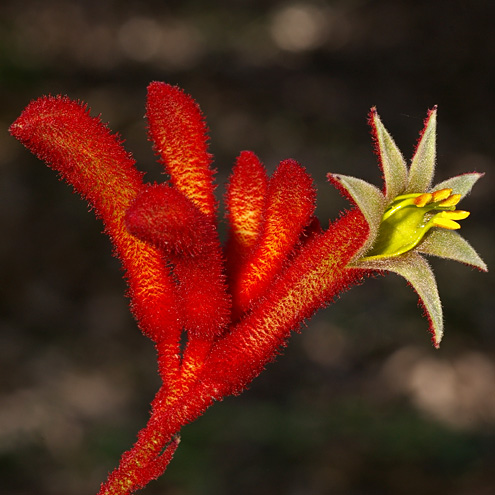General Description:
The Kangaroo Paws comprise a small group of 11 species in the genus Anigozanthos and a single species in the genus Macropidia. They are perennial herbs consisting of strap-like leaves arising from underground rhizomes. Flowers occur in clusters on stalks which emerge from the bases of the leaves. A number of species die back to the rhizome in summer, regenerating in autumn. All species are restricted in distribution to the southern areas of Western Australia.
Kangaroo paws are popular in cultivation but the smaller, spectacular species can be short lived. The handiest species is A. flavidus but the flowers of its normal form tend to be a fairly drab greenish colour. There are red, pink and orange forms of A.flavidus but even they tend to be fairly dull in colour. They have other benefits, of course – they are great for attracting birds to the garden and they are very long-lived and robust plants, often sending flowering stems 2 – 2.5 metres high.
A more attractive group of plants for the garden are the hybrids of A.flavidus with either A.rufus or A.pulcherrimus. These are available in a range of reds (rufus hybrids) or yellows (pulcherrimus hybrids). These hybrids are less robust than the normal form of A.flavidus but have proved to be very hardy in a range of soils and climates.
Anigozanthos ‘Big Red’ is one of the rufus hybrids. it is a clumping plant with leaves 250 mm long. The clusters of tomato-red flowers are up to 40 mm long and occur on stems to 1.5 metres in height. Flowering occurs over a long period from late spring to mid summer.
For best flowering, A. “Big Red” should be located in a sunny position and be well watered. Annual fertilising after flowering using a general purpose fertiliser may be beneficial.
As A. ‘Big Red’ is a hybrid, seed, if it is set, will not produce plants similar to the parent. As with all cultivars, propagation needs to be carried out by vegetative means, in this case by division of the clump, usually after flowering. Hybrid kangaroo paws are propagated commercially by tissue culture.
Further Reading: Hopper, S (1993): “Kangaroo Paws and Catspaws – A Natural History and Field Guide”, Department of Conservation and Land Management, Western Australia.

Anigozanthos ‘Big Red’
Photo: Brian Walters
 Australian Native Plants Society (Australia)
Australian Native Plants Society (Australia)













